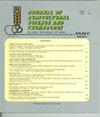盐胁迫下三种棉棉接种根食菌的生长和碳水化合物组成
IF 1.3
4区 农林科学
Q2 AGRICULTURE, MULTIDISCIPLINARY
引用次数: 0
摘要
盐胁迫在耕地上的扩大影响了植物的生理功能,降低了作物产量。丛枝菌根真菌(AMF)作为盐胁迫的生物改良菌,通过改变双糖和多糖的代谢来保护细胞渗透。本研究以3种棉属植物(G. hirsutum、G. barbadens e和G. herbaceum)为研究对象,在盐水灌溉(ECe< 4 Ds m -1 = S0, 8-9= S1, 12-13= S2)条件下进行了根瘤菌(有AMF和无AMF)定殖。开花期开始进行盐度处理。总体而言,从生理性状来看,[+AMF]定殖于barbadense的G.对12 ~ 13 dS m -1盐的耐受性较好,而[+AMF]定殖于hirsutum的耐受性仅为8 ~ 9 dS m -1。这是因为在8-9 dS m -1和12-13 dS m -1处理下,巴贝登叶面积最大,叶面积最小。在12 ~ 13 dS m -1条件下,巴氏根的根体积、根干重、种子重和纤维重最高[+AMF]。在12 ~ 13 dS m -1处理下,巴贝登根和叶片中糖含量最高,根、叶和种子子叶中淀粉含量最高。8-9岁以下。m -1盐胁迫下,巴氏根淀粉、蔗糖磷酸合酶(SPS)和蔗糖磷酸酶(SP)活性最高[+AMF]。本研究表明,尽管高盐条件下与低盐条件下的生理变化较大,但在12-13 dS m -1条件下,AMF和barbadense的共生性能最好。本文章由计算机程序翻译,如有差异,请以英文原文为准。
Growth and Carbohydrate Compositions of Three Gossypium Species Inoculated with Rhizophagus intraradices under Salinity Stress
Expansion of salt stress in cultivable fields prevents plant physiological functions and reduces crop yield. Arbuscular Mycorrhizal Fungi (AMF), as a bio-amelioration of salt stress, protects cellular osmosis via disaccharide and polysaccharide metabolism changes. In this study, three Gossypium species (i.e., G. hirsutum, G. barbadens e, and G. herbaceum ) colonized with Rhizophagus intraradices [with AMF and without AMF] were cultivated under saline irrigation treatments (ECe< 4 Ds m -1 = S0, 8-9= S1, and 12-13= S2) as a factorial experiment. Salinity treatments were initiated at flowering. Generally, according to physiological traits, [+AMF] colonized with G. barbadense was more tolerant in exposure to 12-13 dS m -1 salinity, while G. hirsutum with [+AMF] was just tolerant until 8-9 dS m -1 . This is because, the highest and the least leaf area were observed in G. barbadense [+AMF] under 8-9 and 12-13 dS m -1 , respectively. In 12-13 dS m -1 , the highest root volume, root dry weight, seed weight, and fiber weight were obtained in G. barbadense [+AMF]. Moreover, the highest sugar content in root and leaves and the highest starch content of root, leaves, and seed cotyledon were observed in G. barbadense [+AMF] under 12-13 dS m -1 treatment. Under 8-9 dS.m -1 salinity, the highest starch, Sucrose Phosphate Synthase (SPS) and Sucrose Phosphatase (SP) enzyme activities were in roots of G. barbadense [+AMF]. The present study suggests that despite dramatic physiological alterations under high-salinity in comparison with mild-salinity, AMF and G. barbadense showed the best symbiotic performance under 12-13 dS m -1 .
求助全文
通过发布文献求助,成功后即可免费获取论文全文。
去求助
来源期刊

Journal of Agricultural Science and Technology
AGRICULTURE, MULTIDISCIPLINARY-
CiteScore
1.90
自引率
8.30%
发文量
0
审稿时长
4.5 months
期刊介绍:
Journal of Agricultural Science and Technology is one of the TMU Press journals that is published by the responsibility of its Editor-in-Chief and Editorial Board in the determined scopes.
Journal of Agricultural Science and Technology (JAST) is an international research journal published bimonthly for the purpose of advancing the scientific studies. The subjects covered by JAST include all aspects of agriculture and natural resources (see Areas Covered). The journal will consider submissions from all over the world, on research works not being published or submitted for publication towards publication as full paper, review article and research note. The Papers are published in English with an extra abstract in Persian.
 求助内容:
求助内容: 应助结果提醒方式:
应助结果提醒方式:


